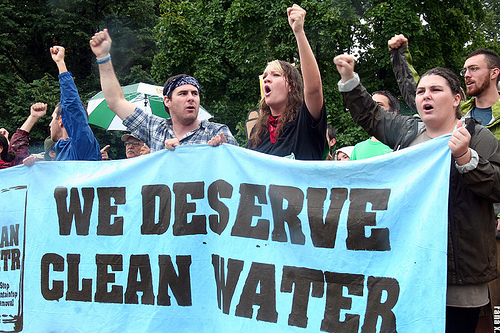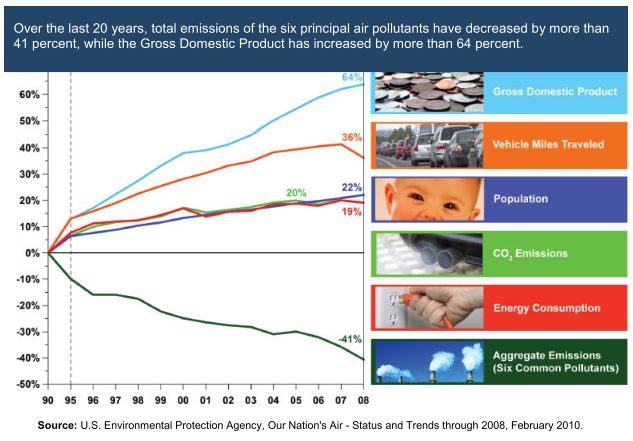In my last post, I noted that industry and government economists alike have consistently overestimated the cost of air-quality regulations. Despite that well-established record of inaccuracy, every new round of apocalyptic projections is taken as gospel by legislators and the Beltway media. As the EPA considers a raft of new and updated regulations, including regulations on greenhouse gases, the issue is back on the front burner.
So it’s great to see a new report — “The Clean Air Act’s Economic Benefits: Past, Present and Future” [PDF], from M.J. Bradley & Associates, the Main Street Alliance, and the Small Business Majority — that reviews the available research on the cumulative costs and benefits of the Clean Air Act. Guess what? The CAA is a bargain! Turns out industry and government projections were overly high in the early ’70s. And the late ’70s. And 1990. Every time the act was expanded or amended, really.
The CAA mandates that EPA itself review the economic effects of the program periodically, and the agency has done so twice, quite painstakingly. In congressional testimony, economist Alan Krupnick of Resources for the Future said that EPA’s studies of the Clean Air Act “are probably the most intensive and expensive cost-benefit analyses ever done at the agency. Under the auspices of the agency’s Science Advisory Board, both studies were scrutinized throughout the decade-long preparation by at least three expert committees of outside economists, air-quality modelers, epidemiologists, and other health experts.” The results of those EPA studies are here; this is what they show in a nutshell:
(“Central estimate” is the mean of the range of estimated benefits, which can be quite large. For instance, the benefits from 1970-1990 were estimated at between $6 and $50 trillion. It goes to show that while costs are easy to quantify, benefits are not, which is one reason cost-benefit analysis tends to be so reactionary in practice.)
Other independent analyses, including by the Office of Budget and Management, have also found that the public benefits of EPA’s air regulations far outweigh the costs. It’s certainly clear that efforts to reduce air pollution haven’t unduly affected economic growth:
That doesn’t look much like economic apocalypse to me. It looks like America getting richer, cleaner, and healthier all at once. Yet the lesson never seems to sink in:
The initial cost estimates for [Phase I of the 1990 acid rain program] were:
• $2.4 billion per year (ICF Consulting, for the National Wildlife Federation)
• $3.9 billion per year (Peabody Coal)
• $3-4 billion per year (Office of Technology Assessment)
• $4-5 billion per year (Edison Electric Institute)
Guess what the Energy Information Administration found were the actual levelized costs of compliance? $836 million a year. But hey, what’s an error of a few billion dollars a year among friends?
The EPA overestimates costs too. A study [PDF] by economists at Resources for the Future found that out of 17 cases, EPA’s initial cost projections overestimated actual costs in 14 and were too low in just three. One reason for this persistent pattern is that it’s just extraordinarily difficult to predict technological innovation. Another is that industry itself is often the source of EPA cost estimates:
Even if regulators are skeptical of industry’s estimates, the estimates establish a standard that must be addressed in the rulemaking process. The agency must justify its actions if it rejects the industry numbers; a simple suspicion will not do legally. Thus, the mere existence of industry studies may exert upward pressure on regulators’ cost estimates.
And don’t think industry doesn’t know that and manipulate the process to its advantage.
And so it goes. “Today’s forecasts of economic doom are nearly identical — almost word for word — to the doomsday predictions of the last 40 years,” said EPA administrator Lisa Jackson. “This ‘broken record’ continues despite the fact that history has proven the doomsayers wrong again and again.”
History will prove them wrong yet again when the EPA’s upcoming rulings — on mercury, SO2, NOx, and CO2 — prove to be far cheaper to comply with than current cost projections. Between now and then, however, we’ll have to endure relentless attacks on the EPA fueled by numbers that everyone knows, or ought to know, are utterly bogus.
Sooner or later, we’re going to have to accept the good news: Cleaning the air and water and improving public health are perfectly compatible with economic growth.
[UPDATE: I forgot to link to this excellent post from NRDC founder John Adams: “The Clean Air Act at 40: Still Vulnerable to Polluters’ Falsehoods.” Definitely worth a read.]





